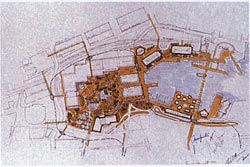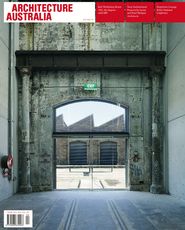HOUSING
I have been following Carey Lyon’s editorials with particular interest, especially “Culture Wars – Missing in Action?” (Architecture Australia vol 96 no 1, Jan/Feb 2007) and “McMansions – We’re livin’ it” (Architecture Australia vol 95 no 5, Sept/Oct 2006).
I’d like to engage, however, with Ian McDougall’s “Why Architecture Matters 1” (Architecture Australia vol 96 no 1, Jan/Feb 2007), particularly his comment that “there is still little architectural interest in affordable, well-designed homes in the suburbs”.
Why, as a profession, do we believe this to be the case? The phrase “well-designed” is patronizing to the general public. Part of the reason we have little to no impact on mass housing and the suburbs is intrinsically linked to the way that we portray our nonparticipation.
There is absolutely no-one preventing architects from engaging in a meaningful way with mass housing and the suburbs. In fact, many aligned industry representatives I’ve spoken to find it quite bemusing that architects continue to fl out meaningful engagement by dismissing the suburbs entirely.
Ian McDougall is of the generation who were trained to think in terms of typology and symbols. There’s a direct link between this approach and the suburban projects of Peter Corrigan, which, while high on intellectual capacity, lacked real meaning to those who actually lived in the suburbs and teetered dangerously on the edge of condescension on more than one occasion. Ashton Raggatt McDougall, despite the McKenzie House and proliferated suburban iconography, are now strangely absent from the suburbs.
I’ll tie this into the reHousing conference by highlighting the fact that all the propositions presented were largely academic in nature and carried little or no public interest. I’m constantly amazed that as a profession we continue to approach the issue of mass housing by frustrating ourselves, with posturing as the only response.
Typology and symbol are difficult to bring out within the mass production paradigm of mass housing and the majority of clients just don’t get what we’re on about. Architectural opinion and commentary is considered “irrelevant” and “elitist” to those building McMansions. I believe that architects who have been interested in the suburbs from a cultural/symbolic/ typology point of view need to enter into the sort of industrial processes necessary to create mass housing. We need to be competing with the housing project builders by establishing parallel practices of our own.
Instead of seeing architecture as a fee- and service-based pursuit, architects should, and can, be successfully involved in speculative pursuits. Instead of railing against the way mass housing is procured, we should be embracing its effectiveness in creating vast amounts of housing for a huge diversity of people.
Architects’ greatest failing in Australia is our lack of participation in the economic fundamentals that drive mass housing. We relish the opportunity to create bespoke housing for large fees, with ample time and an informed, intelligent and urbane client. This mode of practice is a blurred vision that was created by us in the sanctuary of our own educational institutions.
To the majority of the general public, nothing of what we care about matters. We need to expand the definition of “well-designed” and recognize that the symbols accepted by the suburbs are not of our making, and that we need to design with no condescension. The biggest hurdle architects face in engaging with the suburbs is the traditional procurement methods we continue to cling to. At present architects involved in housing, other than bespoke work for wealthy clients, are often relegated to a position of importance well below the builder, the real estate agent, the land developer, the local fixtures supplier and perhaps even the majority of the subcontractors.
In economies such as Perth’s, the recent boom and rise of large numbers of middle-class aspirants has generated new housing work for practitioners who normally wouldn’t get a look in. There’s a unique opportunity in such environments to achieve economic work with modest means, but it requires the suspension of some of our elitist beliefs. It also requires that symbol and typology be replaced with gutsy work that people can afford. The issues relating to research, environment and good design are all givens that should be present in the work, but not the main drivers.
Architects interested in mass housing need to look to sources outside our profession. I highly recommend Lyn Richard’s Nobody’s Home (Oxford University Press, 1990), an excellent study into what drives the suburbs.
A new type of architecture that competes with all the economic fundamentals and cultural imperatives of this largely maligned building sector is, I believe, crucial to architects reasserting some authority and reclaiming lost ground. At present, as far as the general public is concerned, the debate we conduct is lost.
ReHousing navel-gazing will continue and will remain in academic realms while the harder, more challenging and ultimately more rewarding path goes largely unexplored.
Andrew Hagemann, Fringe Architects
MSJ SPECIAL

Original sketch of development strategy, November 1984.
Editor’s note: In response to our special issue, MSJ – The First Forty Years, further clarification has come to light about the design of Darling Harbour, beginning with the following letter:
If I may clarify some points in your article, “Peter Johnson and the Architecture of McConnel Smith and Johnson – The First Forty Years”, MSJ Keys Young Planners did not “undertake the planning, overall design and urban design of” Darling Harbour as stated on page 24 of AA Special Issue:MSJ – The First Forty Years.
The fact is MSJ (Barry Young) consolidated, with great professional skill, a conceptual urban plan already completed some 12 months before they were appointed “design directorate” by the Wran Government.
The original urban design plan for Darling Harbour was developed by Clarke Perry Blackmore Architects and Mort Hoppenfeld (US enterprise development company) as a result of Tom Hayson’s initiative for the rail storage area at Darling Harbour.
I recall clearly the words from Mort Hoppenfeld following the government acceptance of our concept design.
“Guys, the government has some concerns about Hayson Group, of which you are associated, and therefore I am recommending Barry Young (MSJ Keys) be the project directorate (planners). Sorry.” So, the concept we developed jointly with Mort, approved by Neville Wran, was simply removed from our continuing involvement on the basis of a “rumour” about the Hayson Group, originators of the Darling Harbour concept.
Darling Harbour today refl ects, with great accuracy, the original design concept promoted by Hayson and taken onboard by Neville Wran and Laurie Brereton (Minister of Planning for Public Works) and to these other participants credit should also be given.
Robert Blackmore, director, Blackmore Design Group
IN RESPONSE:
• I would like to thank Robert Blackmore for his input regarding the early development of the design for Darling Harbour.
—Jennifer Taylor
• MSJ’s understanding at the time was that the overall concept, which included all the fundamental elements, was developed by Mort Hoppenfeld (presumably, as Robert Blackmore explains, in conjunction with Clarke Perry Blackmore Architects). The MSJ Group was presented with Mort’s A1 butter paper sketch, signed by Neville Wran, Laurie Brereton and others, as well as a written brief from the Darling Harbour Authority and we took it from there. Mort Hoppenfeld had been involved with the waterfront development at Baltimore, which was used as a paradigm for Darling Harbour.
—Mark Willett, MSJ Group















